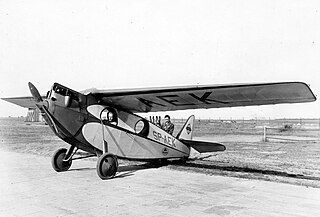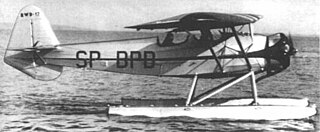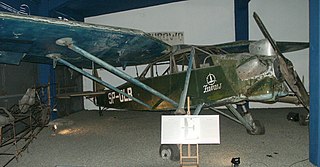
The LWD/WSK Junak was a Polish trainer aircraft, used from 1952 to 1961 by the Polish Air Force and until 1972 by Polish civilian operators. It was designed by the LWD bureau and produced by the WSK Warszawa-Okęcie factory.

The Aero L-60 Brigadýr was a small, high-wing propeller-driven Czechoslovakian STOL utility aircraft developed for both civil and military use. A prototype, designated XL-60, with Argus As 10C engine, first flew on December 24, 1953, but it was not successful. The plane was thoroughly redesigned and the second improved prototype, with M-208B flat-six engine, flew on June 8, 1954. The aircraft's configuration bears a strong resemblance to the Fieseler Fi 156 "Storch" licence-produced in Czechoslovakia during and after World War II, and which this aircraft was intended to replace. By the end of production in 1960, 273 had been built by Aero, including an improved version, the L-160 with an all-metal tail.

The Shvetsov M-11 is a five-cylinder air-cooled radial aircraft engine produced in the Soviet Union between 1923 and 1952.

The RWD 4 was a Polish sports plane of 1930, constructed by the RWD team.

The RWD 3 was a 1930 Polish sports aircraft and liaison aircraft prototype, constructed by the RWD team, a single-engine high-wing monoplane.

The RWD 17 was a Polish aerobatics-trainer aircraft of 1937, parasol wing monoplane, constructed by the RWD team.

The RWD 9 was a Polish sports plane of 1934, constructed by the RWD team.

PZL M-4 Tarpan was a Polish trainer and sports aircraft prototype of the 1960s, designed in WSK-Mielec.

The LWD Szpak (starling) was a Polish utility aircraft of 1945, the first Polish aircraft designed after World War II and built in a short series.

The LWD Żak was a Polish touring and trainer aircraft of the late 1940s, designed in the LWD and built in a short series.
The PZL M-24 Dromader Super is a single engine agricultural aircraft, developed in the 1980s by the WSK-Mielec from the PZL-Mielec M-18 Dromader. It did not progress beyond the prototyping stage.

The PZL-105 Flaming (flamingo) is a Polish short-takeoff-and-landing (STOL) utility aircraft designed by PZL "Warszawa-Okęcie". It remained a prototype.

The PZL S-4 Kania 2 was a Polish trainer and glider towing aircraft of the 1950s, not built in series. The first prototype was designated S-3 Kania. There is also a helicopter named PZL Kania.

The Bartel BM.4 was a Polish biplane primary trainer aircraft used from 1929 to 1939 by the Polish Air Force and Polish civilian aviation, manufactured in the Samolot factory in Poznań. It was the first plane of Polish design put into production.

The JD-2 was a Polish sports plane of 1926. It was the first sports plane designed in Poland, that was built in a small series.

The LWD Żuraw was a Polish utility and liaison aircraft prototype of 1951, a high-wing monoplane with single engine, that did not enter production. The name means crane.

PZL M-2 was a Polish trainer aircraft prototype of 1958, a low-wing monoplane with fixed gear. Designed at WSK-Mielec, it did not enter production.

The RWD 16bis and RWD 21 were Polish two-seat low-wing touring and sports planes of the late 1930s, constructed by the RWD bureau, sharing the same construction, main difference of the RWD 21 being a stronger engine.

The PWS-11 was a Polish aerobatic and trainer aircraft, developed in 1928-1929 by PWS, which remained a prototype.

The CSS-10 was a single-engine two-seat Polish training aircraft of the 1940s. It was a low-wing monoplane with a fixed conventional landing gear. Two prototypes were built, flying in 1948 and 1949, but while a production series of 40 aircraft was planned, a reorganisation of the Polish aircraft industry meant that production did not occur.



















